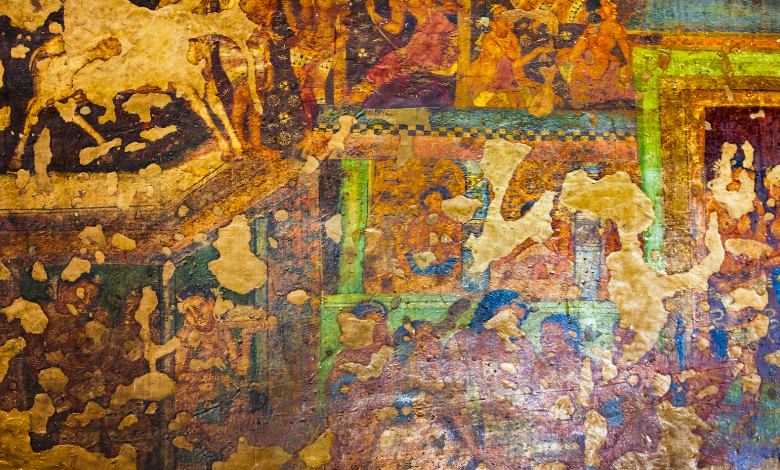Ajanta: Unveiling the Timeless Beauty of India’s Heritage

India, a land steeped in history and cultural richness, is home to a myriad of treasures, and among them, the Ajanta Caves stand as a testament to the artistic brilliance of ancient civilizations. In this journey through time, we’ll explore the intricate details of Ajanta, from its discovery and architectural marvels to its influence on contemporary culture.
Discovery and Architecture
Nestled in the state of Maharashtra, Ajanta Caves were accidentally discovered in the 19th century by a British officer. Dating back to the 2nd century BCE, these caves boast a mesmerizing blend of Buddhist architecture and rock-cut craftsmanship. The complex comprises 30 caves, each unique in its design and purpose.
Fresco Paintings and Artistry
The heart of Ajanta lies in its fresco paintings that adorn the cave walls. These vivid and detailed artworks depict scenes from the Jataka tales, life stories of Buddha, and various mythical narratives. The artistry is not merely a visual delight; it is a profound storytelling medium that captivates visitors with its cultural and historical depth.
Buddhist Influence and Themes
Ajanta is deeply rooted in Buddhism, with many caves serving as monastic retreats. The themes of compassion, enlightenment, and the path to Nirvana are intricately woven into the artwork. The serene ambiance of the caves amplifies the spiritual essence, making Ajanta not just an archaeological site but a spiritual journey.
Evolution of Ajanta Over Centuries
Over the centuries, Ajanta underwent changes and modifications, adapting to different cultural and religious influences. From Hinayana to Mahayana Buddhism, each era left its mark on the caves. Despite the passage of time, Ajanta has retained its historical charm, although preservation efforts face ongoing challenges.
Tourist Attractions and Visitor Experience
Designated as a UNESCO World Heritage Site, Ajanta attracts visitors from across the globe. The intricate carvings, vibrant paintings, and the sheer magnitude of the caves contribute to a unique and awe-inspiring experience. From Cave 1’s imposing facade to Cave 26’s delicate sculptures, each cave tells a distinct story.
Ajanta in Literature and Popular Culture
Beyond its physical presence, Ajanta resonates in literature and popular culture. Poets and writers have penned odes to its beauty, while filmmakers and artists draw inspiration from its timeless allure. Ajanta’s influence extends far beyond its rocky confines, shaping the creative landscape of India.
Preservation Challenges and Efforts
Preserving the delicate artwork within Ajanta poses a significant challenge. Humidity, weathering, and human impact necessitate meticulous conservation efforts. Various organizations and governmental bodies are actively involved in ensuring that Ajanta’s cultural legacy survives for future generations.
Ajanta: A Symbol of India’s Rich Heritage
Ajanta stands as a symbol of India’s rich and diverse heritage. It represents a convergence of artistic, cultural, and spiritual traditions that have shaped the nation’s identity. The caves embody the resilience of Indian civilization, transcending time and leaving an indelible mark on the collective consciousness.
Virtual Tours and Accessibility
In the digital age, Ajanta becomes accessible to a global audience through virtual tours and online platforms. These initiatives allow enthusiasts worldwide to explore the caves, fostering a deeper appreciation for India’s cultural heritage. Ajanta’s virtual presence opens a gateway for cultural exchange and appreciation.
Ajanta: Beyond the Caves
The allure of Ajanta extends beyond the caves themselves. The surrounding areas offer additional attractions, creating a holistic experience for visitors. From serene landscapes to nearby historical sites, Ajanta’s influence extends to the broader tourism ecosystem of the region.
Stories and Legends Associated with Ajanta
Mythical tales and folklore surround Ajanta, adding a layer of mystery and intrigue to its narrative. These stories, passed down through generations, contribute to the cultural richness embedded in the caves. Ajanta becomes not just an archaeological site but a living repository of cultural narratives.
Ajanta’s Influence on Art and Architecture
The impact of Ajanta extends to subsequent art and architectural styles in India. Elements of Ajanta’s design can be traced in temples and structures across the country. Contemporary artists and architects find inspiration in the timeless beauty of Ajanta, connecting the past with the present.
Ajanta’s Role in Cultural Education
Beyond its aesthetic appeal, Ajanta plays a vital role in cultural education. Its inclusion in academic curricula ensures that future generations understand and appreciate the historical and artistic significance of this cultural gem. Ajanta becomes a living classroom, bridging the gap between textbooks and tangible heritage.
Conclusion
As we conclude our exploration of Ajanta, we stand in awe of its timeless beauty and historical significance. Ajanta transcends being merely a collection of caves; it is a testament to human creativity, resilience, and the enduring legacy of India’s cultural heritage. Let us celebrate and preserve this treasure, ensuring that the echoes of Ajanta continue to resonate for centuries to come.
Frequently Asked Questions (FAQs)
- How were the Ajanta Caves discovered?
- The Ajanta Caves were accidentally discovered in the 19th century by a British officer.
- What themes are depicted in the fresco paintings of Ajanta?
- The fresco paintings in Ajanta depict scenes from the Jataka tales, life stories of Buddha, and various mythical narratives.
- Why is Ajanta considered a UNESCO World Heritage Site?
- Ajanta is designated as a UNESCO World Heritage Site due to its historical, cultural, and artistic significance.
- How is Ajanta accessible to a global audience in the digital age?
- Ajanta becomes accessible through virtual tours and online platforms, allowing enthusiasts worldwide to explore its beauty.
- What challenges does Ajanta face in terms of preservation?
- Ajanta faces challenges such as humidity, weathering, and human impact, requiring ongoing conservation efforts.




